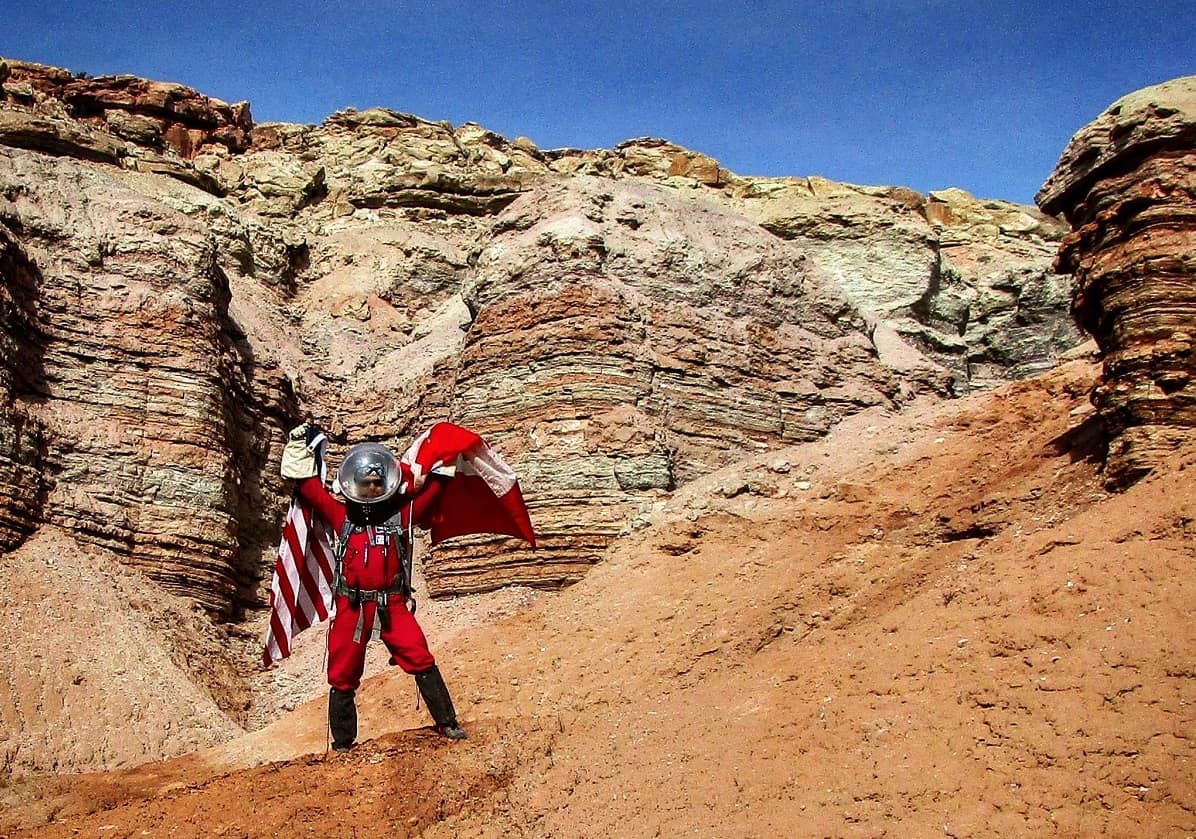Exploring Mars ... in Utah

Surrounded by deep canyons and rugged, scenic sandstone formations resembling the red terrain of Mars, researcher Ryan L. Kobrick paces himself as he climbs about 200 feet up a steep desert mountain in south-central Utah named after one of the moons of Mars.
Making the climb more difficult, he’s wearing unusual equipment, including fans blowing air into an imitation space helmet. Monitors under Kobrick’s protective coveralls track and record his body temperature and heart rate as he maneuvers around loose rocks near the top of Phobos Peak.
“It was grueling. I couldn’t see properly from the helmet fogging up, and it was really steep,” says Kobrick, an assistant professor of spaceflight operations at Embry-Riddle Aeronautical University’s Daytona Beach Campus in Florida. Adding difficulty to the trek, his boots ripped apart during the ascent.
In his simplified version of a spacesuit, Kobrick was on a simulated extravehicular activity as mission commander at the Mars Desert Research Station in the rugged terrain of the San Rafael Swell. The isolated, analogue extraplanetary outpost was established in 2001 by the Mars Society, an international volunteer-driven organization of astronomers, scientists, engineers, astronauts, educators and space enthusiasts.
The biometric protocols used to monitor Kobrick’s ability to move and work in the simulated spacesuit during extraterrestrial activities were developed in Embry-Riddle’s S.U.I.T. (Spacesuit Utilization of Innovative Technology) Laboratory. The work supports NASA’s Human Research Program, which includes studying medical capabilities, human factors, behavioral performance, space radiation and human health countermeasures — all considerations for keeping explorers safe in deep space.
This research also continues Embry-Riddle’s partnership with Final Frontier Design, a company creating advanced safety garments for space and extreme environments. Their work with NASA includes developing lower-cost, next-generation spacesuits and accessories. The S.U.I.T. Lab’s evolving methodologies track the spacesuit validation techniques used by NASA Johnson Space Center.
Embry-Riddle researchers compiled and analyzed data collected from the Mars Desert Research Station mission, other analogue stations in Hawaii and the Arabian Desert of Oman, and from tests in the S.U.I.T. Lab.
Tailor-Made for Space
As they worked to standardize the tracking of body measurements and calculations, Kobrick and his undergraduate student research team found there were limits to the amount of work that could be conducted on extravehicular activities.
On short-duration missions, for example, a daily extravehicular activity may be feasible. But on longer-duration missions, the workload could cause a strain on the extravehicular activity crew. Real-time cardiac and oximetry data would be useful for a mission flight surgeon or crew trainer who is remotely monitoring heart rates and oxygen saturation levels. Using video and 3-D motion capture, researchers have also documented several range-of-motion limitations, with some suits being more restrictive, depending on their construction and fit.
“It’s very demanding on the body, even with a simulated spacesuit, to go out conducting work for four hours or longer,” says Kobrick, who has been on six analogue missions and serves as principal investigator of the S.U.I.T. Lab.
Back in the lab, the support team also learned that remotely gathering data with a pulse oximeter, Bluetooth wireless thermometers and Hexoskin smart shirts while the explorers were hiking and riding all-terrain vehicles created additional limitations.
“For future studies, the biometric equipment we use will have to be more comfortable and flexible to adapt to the changing environments,” says Jenifer Schuman, a S.U.I.T. Lab assistant and Embry-Riddle sophomore majoring in aerospace physiology.
Their findings, presented at the International Conference on Environmental Systems in Albuquerque, New Mexico in July, describe methods for studying range of motion and tracking and analyzing metrics. The research showed that — for long-duration planetary missions — an operational protocol for spacesuit performance analysis should be followed on site. On long-duration missions, Kobrick explains, the complexity of operations means crews won’t have time to work with a support team on Earth to diagnose problems with extravehicular activity spacesuits. With advancements in video capture technology and artificial intelligence, range of motion analysis could be processed in real-time, providing instant feedback to the crew regarding suit performance, Kobrick says.
“A spacesuit is a human’s last line of defense against the hostile environments in outer space. While the suit should be able to save a human’s life in an emergency scenario, it should also allow them to perform the tasks they need to do,” says S.U.I.T. Lab Lead Technician Nicholas Lopac, who is double-majoring in spaceflight operations and human factors at Embry-Riddle.
Preliminary Embry-Riddle results are bound to aid future test protocols and provide participants in upcoming training missions with relevant feedback about the design and function of their simulated spacesuits.
The S.U.I.T. Lab researchers continue to refine their data-gathering capabilities. In-house, the motion-capture system helps create better anthropometric models and virtual environments. Kobrick’s research also reaches far beyond campus, into other remote analogue environments across the planet, where Embry-Riddle’s work helps set standards for testing spacesuits and providing protocol recommendations for extravehicular activity simulations.
“The better we can make the simulations, the better we can prepare crews to go to Mars and beyond,” Kobrick says.
Capturing Motion in 3-D
Inside the S.U.I.T. Lab, four 3-D motion-capture cameras, positioned throughout the room, record participants’ movements with and without a spacesuit for both intravehicular activities within a spacecraft and extravehicular activities on planetary surfaces.
The lab, fully operational since January 2017, establishes protocols for range-of-motion testing on space and analogue training suits, including testing with Final Frontier Design.
The research-focused goals provide a testbed for industry partners to receive feedback, data and recommendations for spacesuit design, while providing hands-on research opportunities for faculty and students.
For example, engineers at Final Frontier Design, who are developing next-generation spacesuits and other garments for NASA and the commercial space industry, came to the lab in April 2017 because they wanted to have a third party quantify the performance of their suit in a well-documented way. The company later returned for motion-capture testing.
Meanwhile, the lab is involved in more than just spacesuits. For example, Kobrick helped test the durability of new gloves by Final Frontier Design during his last mission at Mars Desert Research Station.
Kobrick and his student researchers hope to work with additional industry partners and conduct off-site experiments using portable equipment in the coming year.
Editor’s Note: This article was originally published in the fall 2018 edition of Embry-Riddle’s ResearchER magazine (Vol. 2, No. 2). The ResearchER archives can be found on Scholarly Commons.

 Deborah Circelli
Deborah Circelli